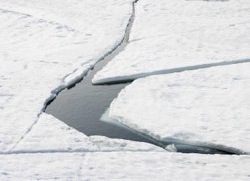
Gull Lake Ice Cover History
Many of us enjoyed the mild winter. When the ice goes off Gull Lake early, like it did this year, we might wonder how the ice cover duration compared to previous years. Did you know that Gull Lake residents have been keeping track of freezing and thawing dates for almost 100 years! There have been three years in recorded history where Gull Lake has failed to freeze over entirely – two years during the dust bowl (1930 and 1931) and again in 2001. The graphs below (courtesy of Dr. Steve Hamilton from KBS), show that ice cover in 2015-2016 was in fact well below the average. Moreover, the long-term data show that ice cover duration on Gull Lake has been decreasing steadily over the last 90+ years (see trend line on the graph). The Gull Lake pattern matches the trend observed on many other Midwestern lakes that have long-term records (in almost all cases, we can thank local residents for meticulously recording ice-on and ice-off over the years.). These long-term changes in ice cover are the result of global warming, but are also modified by natural climate patterns such as El Nino and the North Atlantic Oscillation (NAO). What will next year hold? Who knows? As scientists like to say, “Climate isn’t weather.” Long-term trends in temperature (and ice cover) are observable and can be correlated with changes in the atmosphere. On the other hand, short-term events, like tomorrow’s weather or next year’s ice cover, aren’t as predictable. Also unpredictable (at least for now) are the consequences of reduced ice cover for animals and plants living in Gull and other Michigan lakes.
Ice Cover Update provided by Gary Mittelbach, MSU, Kellogg Biological Station.
Review Gull Lake Ice Cover records provided by Steve Hamilton, MSU, Kellogg Biological Station.
